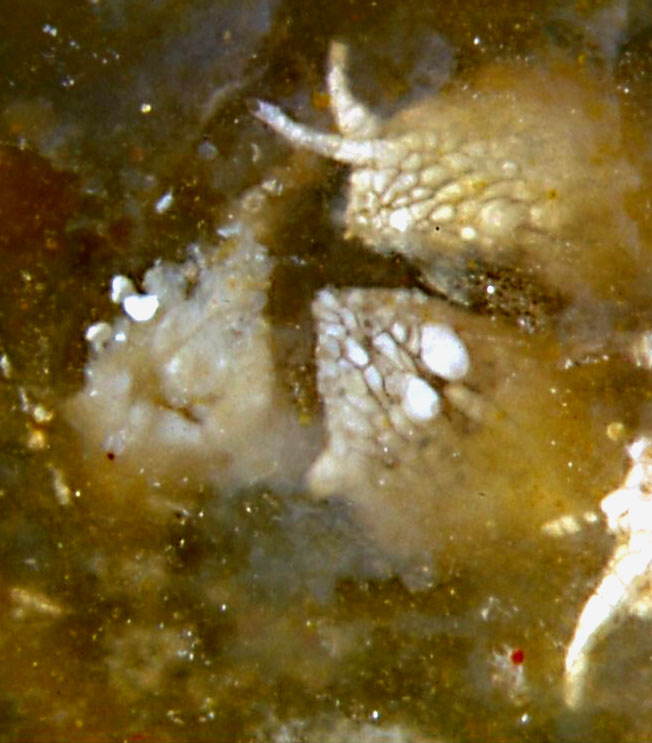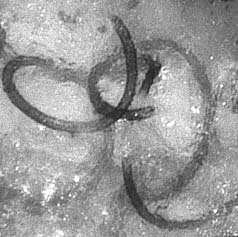Fossiliferous
cherts

Unlike the conspicuous slabs with large compressed fossils
often seen in museums, fossiliferous cherts usually do not make large
fossil exhibits but nevertheless impressive samples if cut and
polished, with life-like three-dimensional
preservation in partially transparent chalcedony, often beautifully
coloured. The preservation of tiny detail even
on the micrometer scale contributes to their
scientific value.
Photograph: Evidence for preservation of tiny detail in transparent
chalcedony. Sporangia of the tree fern Scolecopteris with
clearly seen cells on the surface,
quite uncommon variety with two hairs emerging near the pointed top
of the capsules, (cut off at the lower
sporangium, seen as white spots,) unknown
species ?
Lower Permian, Döhlen basin, Saxony, Germany.
Fossiliferous cherts have not received due attention as they
are most often found as pebbles in gravel pits and
fluvial deposits and along rivers but
rarely as outcrops, which makes them unsuitable for stratigraphy.
As an exception to this rule, most of the famous Rhynie chert recovered
hitherto, now stored at museums and universities and not yet fully
investigated, was dug up by
trenching into subcrops of in-situ chert layers [1]. Smaller amounts
have been found scattered in the area, with sizes of a few grams up to
65kg.
Big chert boulders are rare because the layers break into pieces while
being
washed out of the banks and carried along by the river. The width of
the fragments is usually not much larger than the thickness of the
chert
layer. The width can even be smaller if the
brittle layer had been bent by deformation of the stratum where it is
embedded.
The biggest chert boulder from Döhlen
basin is a Lower Permian chert of 31kg with numerous fern frond
fragments, found in a trench in a glazial fluviatile deposit at
Hänichen near Dresden.
The lately increased interest in fossiliferous cherts in
Saxony
has been brought about by lucky incidences: (1) first new find of a
"maggot stone" since 1893 by Gert
Müller in 1985 after purposeful search, (2) essay on the
old "maggot
stone" finds by M.
Barthel
1987 [2], which encouraged the present writer to look for fossiliferous
cherts in a wider area, (3) earthwork and construction pits in
fluviatile deposits with
fossiliferous cherts, since 1991. This interest is held up mainly
by the
activity of non-professionals who are fascinated by the
encounter with ancient life forms but don't care
much about stratigraphy. Ralph Kretzschmar had
created the website www.kieseltorf.de, which enabled
lay fossil collectors and himself to make known their finds and
discoveries. It is
deplorable that this dedicated staff
member at the Naturkunde-Museum
Chemnitz, who had advanced from self-taught paleontologist to the
supervisor of excavations, suddeny quit his job, deleted his website,
and turned away
from paleontology in 2017. (In this connection, Fossil Wood
News 16 may
be revealing.)
It is strongly emphasized that the field work of collecting
fossiliferous
cherts differs much from searching for and recovering compression
fossils in sediment rocks where a hammer is a suitable tool.
Fossiliferous chert pebbles and boulders should never be hit with
a hammer. Same as agate pebbles and silicified wood, they should be cut
with special blades, after inspection from outside and
choosing a
suitable cutting plane. Luckily, stone cutting with
narrow blades is a widespread trade nowadays.
Judging from experience, anyone who has
carried with him or her a hammer for hours feels the urge to hit
something with it, which can mean the destruction of a unique fossil by
irrecoverably shattering it to pieces. Also, most often details are
poorly visible on a fracture face but
better on the naturally smoothed surface. The
safest way to
resist the temptation
to shatter a valuable sample is to leave the hammer at home and take a
pickaxe or big chisel along to poke into the ground or into the gravel
banks.
In order to show that the danger of irreparable damage is real, a
confession of the venerable A.G. Lyon
is
quoted here:
"Preliminary
examination, by removing small chips with a hammer, ... .
Unfortunately, during the preliminary examination, the block shattered,
but two related pieces of moderate size were recovered ..." [3]. Hence,
the title of the related publication reads "On the fragmentary remains
...". In
fact, no chert piece
equalling the shattered one has been found within
half a century, hence the true size and
shape of the fossil have remained obscure.
Incidentally, a fossil closely related to the shattered one serves as
evidence that one can find tiny things by
carefully inspecting the
smooth natural surface of the chert piece:
See photograph and Rhynie
Chert News 29 , 51 , 156.

H.-J.
Weiss 2010
emended
2015, 2018, 2020
[1] N.H. Trewin:
History of research on the
geology and
palaeontology of
the Rhynie area, Aberdeenshire, Scotland.
Trans. Roy. Soc. Edinburgh 94 (2004
for 2003), 285-97.
[2] M.
Barthel: Der Madenstein aus dem Rotliegenden des
Windberges.
in: H. Prescher u.a.:
Zeugnisse der
Erdgeschichte Sachsens, Leipzig 1987, S.121.
[3] A.G. Lyon:
On the fragmentary remains of an organism
referable to the nematophytes, ..., Nematoplexus
rhyniensis gen. et sp. nov.
Trans. Roy. Soc. Edinburgh
LXV (1961-62), 79-87, 2 plates.

